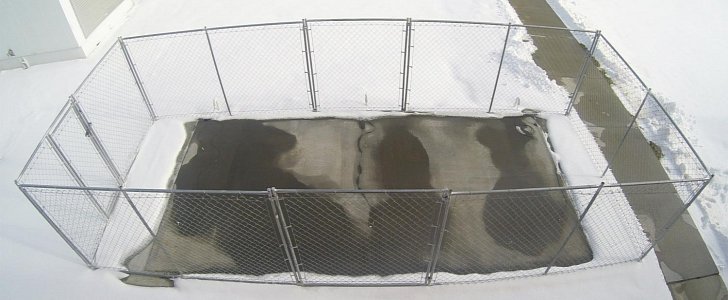The main bad thing about ice and snow, apart from the fact that they’re slippery, is that once they get comfortable on our roads, the plows are called in to push them out of the way, while salt or other de-icing chemicals are spread over the driving surface.
If you’ve ever been caught behind a convoy of plows, you’ll know how annoying it is to drive at their speed without the possibility of overtaking them, but that’s not the biggest problem. It’s the substances used to melt ice.
The problems caused by these chemicals are endless, and this sometimes makes you wonder if the benefits are actually worth it. Maybe the Swedes do know what they’re doing when they don’t clear their roads of snow.
We do, however, and we also spray them with a substance that corrodes the concrete, generates potholes, is a nightmare for the cars’ paintwork, and it’s a pain to get off your shoes. But what if there was an alternative?
An engineering professor at the University of Nebraska is currently testing out a new method of keeping the concrete clean during the winter. Chris Tuan took the heated driveway principle one step forward, and instead of placing heated wires or pipes under the concrete, he put them in it. Kind of.
The idea seems simple now, but that doesn’t change the fact that he’s the first one to come up with it. Chris Tuan mixed steel shavings and carbon particles into the usual concrete recipe and came up with something that can conduct electricity and generate heat as a result.
“Will it zap me if I walk over it while it’s in action?” Glad you asked. Wouldn't that be funny? The answer, though, is no.
The Phys website reports that, currently, there’s only a test patch of 200-square-feet (apart from a patio in the inventor’s backyard), but the next phase of the project will see the system get implemented in a US airport, under the FAA’s supervision. Unlike what you’d think, it’s not the runways that are being targeted, but the tarmac around the gated areas - clearing that up would speed things considerably during bad weather.
It’s hard to imagine this thing on a very large scale. It would require tearing up the existing concrete and replacing all of it with Tuan’s mixture, which would cost nothing short of a fortune. But in key areas - bridges, for example, which tend to freeze a lot quicker and are also corroded by the salt normally used - that’s where his invention could make a lot more sense.
That means that for the other 99.9 percent of the roads, the snow plow is here to stay.
The problems caused by these chemicals are endless, and this sometimes makes you wonder if the benefits are actually worth it. Maybe the Swedes do know what they’re doing when they don’t clear their roads of snow.
We do, however, and we also spray them with a substance that corrodes the concrete, generates potholes, is a nightmare for the cars’ paintwork, and it’s a pain to get off your shoes. But what if there was an alternative?
An engineering professor at the University of Nebraska is currently testing out a new method of keeping the concrete clean during the winter. Chris Tuan took the heated driveway principle one step forward, and instead of placing heated wires or pipes under the concrete, he put them in it. Kind of.
The idea seems simple now, but that doesn’t change the fact that he’s the first one to come up with it. Chris Tuan mixed steel shavings and carbon particles into the usual concrete recipe and came up with something that can conduct electricity and generate heat as a result.
“Will it zap me if I walk over it while it’s in action?” Glad you asked. Wouldn't that be funny? The answer, though, is no.
The Phys website reports that, currently, there’s only a test patch of 200-square-feet (apart from a patio in the inventor’s backyard), but the next phase of the project will see the system get implemented in a US airport, under the FAA’s supervision. Unlike what you’d think, it’s not the runways that are being targeted, but the tarmac around the gated areas - clearing that up would speed things considerably during bad weather.
It’s hard to imagine this thing on a very large scale. It would require tearing up the existing concrete and replacing all of it with Tuan’s mixture, which would cost nothing short of a fortune. But in key areas - bridges, for example, which tend to freeze a lot quicker and are also corroded by the salt normally used - that’s where his invention could make a lot more sense.
That means that for the other 99.9 percent of the roads, the snow plow is here to stay.

